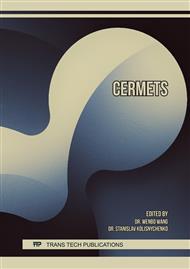[1]
L. Q. Zheng, F. Y. Gao, S. X. Zhao, F. Y. Zhou, J. P. Nshimyimana, X. G. Diao, Optical design and co-sputtering preparation of high performance Mo-SiO2 cermet solar selective absorbing coating, Applied Surface Science. 280 (2013) 240-246.
DOI: 10.1016/j.apsusc.2013.04.142
Google Scholar
[2]
X. Chen, W. H. Xiong, Z. H. Yao, G. P. Zhang, S. Chen, Q. Q. Yang, Characterization of Ti-based solid solution cermets prepared by mechanically induced self-sustained reaction and subsequent pressureless sintering, Journal of Alloys and Compounds. 583 (2014).
DOI: 10.1016/j.jallcom.2013.08.120
Google Scholar
[3]
S. Q. Guo, Reactive hot-pressing of platelet-like ZrB2-ZrC-Zr cermets: Processing and microstructure, Ceramics International. 40 (2014)12693-12702.
DOI: 10.1016/j.ceramint.2014.04.117
Google Scholar
[4]
M. A. Farrokhzad, G. C. Saha, T.I. Khan, Wear performance of co-electrodeposited cermet coatings, Surface & Coating Technology. 235 (2013) 75-85.
DOI: 10.1016/j.surfcoat.2013.07.015
Google Scholar
[5]
B. Wang, D. F. Bliss, M. J. Callahan, Hydrothermal growth of Ti:sapphire (Ti3+: Al2O3) laser crystals, Journal of Crystal Growth. 311 (2009) 443-447.
DOI: 10.1016/j.jcrysgro.2008.09.052
Google Scholar
[6]
H. J. Tao, K. Peng, Y. Q. Xie, Y. H. He, Z. M. Yin, Research advance on brittleness of Ti-Al intermetallics, Materials Science and Engineering of Powder Metallurgy 12 (2007) 330-336.
Google Scholar
[7]
Z. C. Xie, T. H. Gao, X. T. Guo, X. M. Qin, Q. Xie, Glass formation and icosahedral medium-range order in liquid Ti-Al alloys, Computational Materials Science. 95 (2014) 502-508.
DOI: 10.1016/j.commatsci.2014.08.023
Google Scholar
[8]
C. F. Gutierrez-Gonzalez, E. Fernandez-Garcia, A. Fernandez, R. Torrecillas, S. Lopez-Esteban. Processing, spark plasma sintering, and mechanical behavior of alumina/titanium composites, Journal of Materials Science. 49 (2014) 3823-3830.
DOI: 10.1007/s10853-014-8095-5
Google Scholar
[9]
K. Edalati, H. Iwaoka, Z. Horita, et al, Unusual hardening in Ti/Al2O3 nanocomposites produced by high-pressure torsion followed by annealing, Materials Science and Engineering A. 529 (2011) 435-441.
DOI: 10.1016/j.msea.2011.09.056
Google Scholar
[10]
M. J. Liu, Z. Wang, X. W. Luan, J. Y. Wu, Q. G. Li, Effects of CeO2 and Y2O3 on the interfacial diffusion of Ti/Al2O3 composites, Journal of Alloys and Compounds. 656 (2016) 929-935.
DOI: 10.1016/j.jallcom.2015.10.043
Google Scholar
[11]
X. L. Li, R. Hillel, F. Teyssandier, S. K. Choi and F. J. J. Vanloo, Reactions and phase relations in the TiAlO system. Acta Metall. Mater. 40 (1992) 3149.
DOI: 10.1016/0956-7151(92)90478-w
Google Scholar
[12]
A. M. Kliauga, M. Ferrante, Interface compounds formed during the diffusion, Interface compounds formed during the diffusion bonding of Al2O3 to Ti, Journal of Materials Science. 35 (2000) 4243-4249.
Google Scholar
[13]
L. Hua, C. L. Bao, D. H. Shen, et al, Study of the Ti/Al2O3 interface, Journal of Materials Science. 30 (1995) 339-346.
Google Scholar
[14]
R. Pan, Q. Wang, D. Sun, P. He. Effects of electric field on interfacial microstructure and shear strength of diffusion bonded a-Al2O3/Ti joints, Journal of the European Ceramic Society. 35 (2015) 219-226.
DOI: 10.1016/j.jeurceramsoc.2014.07.025
Google Scholar



